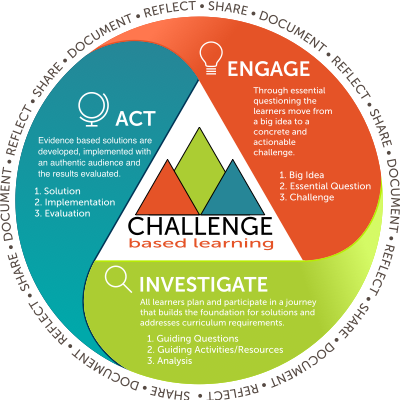FRAMEWORK

The Challenge Learning Framework includes three interconnected phases: Engage, Investigate and Act. Each phase includes activities that prepare you to move to the next phase. There are opportunities within each phase for mini-exploration cycles and, if necessary, a return to an earlier phase. Supporting the entire process is an ongoing process of documentation, reflection and sharing.
ENGAGE
During the Engage Phase, the Learners move from an abstract big idea to a concrete and actionable challenge using the Essential Questioning process. The goal is to personally connect with academic content by identifying, developing, and owning a compelling challenge.
Big Ideas
A Big Idea is a broad theme or concept presenting multiple possibilities for exploration and is important in the learner’s context and the larger community. Examples of big ideas include Community, Relationships, Creativity, Health, Sustainability, and Democracy.
Essential Questioning/ Essential Question
By design, the big idea generates essential questions that reflect personal interests and the community’s needs (e.g. Why is this important to me? Where does this concept intersect with my world? etc.). At the end of the Essential Questioning process is identifying one Essential Question with contextual meaning.
Challenges
The challenge turns the essential question into a call to action to learn deeply about the subject. A challenge is actionable and builds excitement.
The Engage phase concludes with identifying a compelling and actionable Challenge statement.
INVESTIGATE
Building from the Challenge Learners develop contextualized learning experiences and conduct rigorous, content and concept-based research to create a foundation for actionable and sustainable solutions
Guiding Questions
The Investigation phase begins with generating questions related to the Challenge. The questions develop the course of study needed to develop an informed solution to the Challenge. The questions are categorized and prioritized, creating an outline for the learner’s journey.
Guiding Activities/Resources
Learners identify and use Guidign Resources or activities to answer the Guiding Questions while working towards innovative, insightful, and realistic solutions. Examples of Guiding Resources include online content and courses, databases, textbooks, and social networks. Examples of Guiding Activities include simulations, experiments, projects, problem sets, research, and games.
Synthesis
After answering the Guiding Questions and identifying insights, the learners analyze the accumulated data and identify themes.
The Investigation phase concludes with reports and presentations demonstrating the learners have successfully addressed all of the Guiding Questions and developed clear conclusions, setting the foundation for the solution while meeting learning goals and objectives.
ACT
In the Act Phase, evidence-based solutions are developed and implemented with an authentic audience and the results evaluated. The Learners combine a desire to make a difference with a demonstration of content mastery.
Solution Concepts
After completing the Investigation phase, the learners have a solid foundation to develop solution concepts. Solution concepts may involve plans for a campaign to inform or educate, school or community improvement projects, product development, or other activities.
Solution Development
After the solution concept is approved, the learners develop prototypes, experiment and test. This iterative design cycle will likely raise new Guiding Questions requiring further research and may swing learners back into the Investigation Phase.
Implementation and Evaluation
After developing their solutions, the learners implement them, measure outcomes, reflect on what worked and what didn’t and determine their impact on the challenge.
When implementation is complete, learners can continue to refine the solution or develop a completion report and share their work with the rest of the world.
REFLECT, DOCUMENT, & SHARE
Learners document their experience using audio, video, images, and photography throughout the Challenge. The ongoing collection of content provides the resources for reflection, Informative assessment and the documentation of the learning process.
